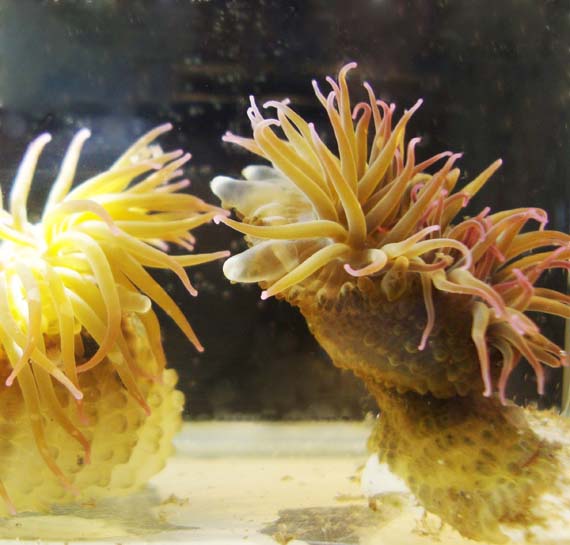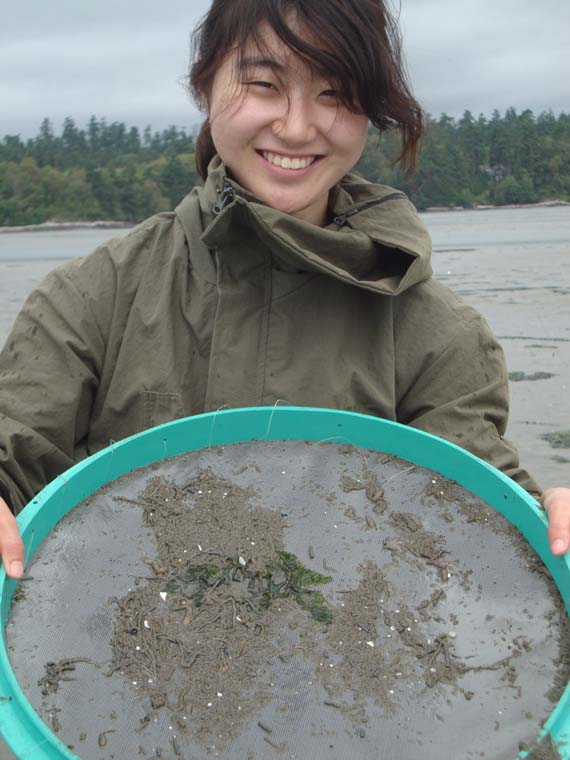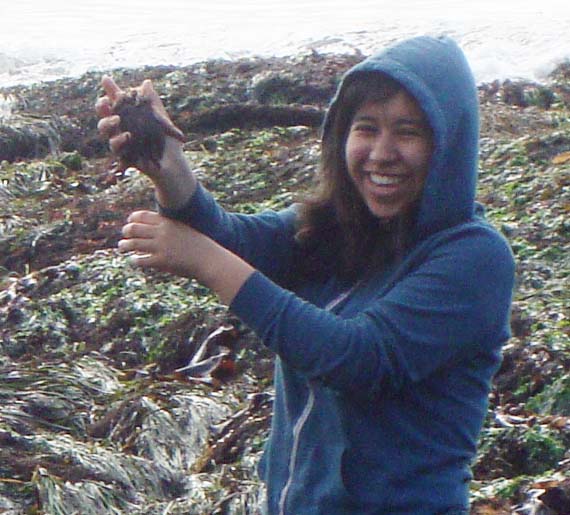Polyps and cukes and crabs, Oh My!
Rachel Merz
Mark Levine-Weinberg, Leah Lee and Samantha Chavez joined me as three of this summer’s NSF REU/Blinks/BEACON undergraduates who did research at Friday Harbor. They worked on very different projects, which arose from fundamental observations each of them made in the field and the questions that they developed from those observations. The process began by all of us using a low tide series to visit a number of habitats around San Juan Island (Cattle Point, False Bay, Eagle Cove, Garrison Bay, Argyle Creek and the FHL dock). In each setting, the students followed their curiosity to explore the habitat and develop a sense of the organisms living there. At the end of each day, after visiting a site, I would ask, “If you were going to do a project based in this setting, what are the organisms and questions that are most interesting to you?” At the end of the week of low tide explorations, each student had two or three questions that had really caught his or her imagination. They then used the following week, until the next series of negative tides, to more closely observe their organisms in the lab, and we began an ongoing discussion about how to answer their questions of interest. This required the students to further develop their ability to search for and read the relevant literature. They also had to think about how to design experiments or make measurements that would lead to answers to their questions, and, finally, estimate how feasible a given project would be.

Mark Levine-Weinberg first found the rocky intertidal at Cattle Point to be an almost bewildering landscape, with so many organisms packed so tightly that it was initially difficult for him to see patterns and to understand what was going on. Even though he had read about this habitat and seen many pictures of it, the reality was surprising and confounding. Nonetheless, he began to find himself puzzling about the clonal sea anemones Anthopleura elegantissima. By bringing them into the laboratory, he became more familiar with their morphology and behavior and was able to induce battles between non-clone mates. “Definitely the coolest feature of the anemone I worked with, A. elegantissima, is that it not only has specialized battle tentacles for fighting off competitors, but that this aggressive response is highly specific. They won't attack members of their own clone, but they WILL attack members of the same species not in their clone, as well as other species in Class Anthozoa!” Mark reasoned that individuals that are in the upper reaches of their species’ intertidal distribution are exposed for longer times during low tides and are therefore more physiologically challenged by extremes of temperature, U.V. exposure, salinity and desiccation. They are also more limited in the time they have to get nutrition than members of their species living lower in the intertidal. He then wondered if the “cost” of being in the upper intertidal would limit the aggressive response of the high intertidal anemones compared with those living in the physiologically more benign lower intertidal. To test this idea, in the lab he staged battles between size-matched individuals from high and low intertidal clones from Cattle Point against a common “enemy” – individuals from a clone growing on the rocks in front of the lab. The data processing from more than 80 battles recorded on time-lapse video is still going on, but it is clear that anemones from the lower intertidal have significantly more specialized battle tentacles (acrorhagi) and in most battle metrics they are at least slightly more aggressive than those from high intertidal. Of this experience, he says, “Being able to conduct such a large quantity of research in my nine weeks on the island was instrumental in my feeling prepared going into my senior year at Swarthmore. Knowing that I have a wealth of data to analyze, thanks to the availability of resources and support I received at the labs, means there is one less thing I will worry about as I prepare my thesis for the Spring.”

Leah Lee, also from Swarthmore College, was equally fascinated by the “kettle drum” tunicates growing on the dock and the enormous numbers of worm-like sea cucumbers burrowing through the False Bay sediments. After a mighty struggle to decide which offered the most interesting project she settled on the sea cucumbers. About them, she says, “I think the coolest thing about Leptosynapta clarki is that it moves really slowly. Because it moves so slowly, it is very difficult to observe how it moves in real time and its movement can only be fully appreciated on time-lapse video. It is also surprising how abundant Leptosynapta clarki is in False Bay, considering its slow movement and seeming lack of escape response.” By using time-lapse video she was able to document that these sea cucumbers could elongate more than three times their contracted body length (imagine if our bodies could extend to 15 to 18 feet!). They do this by using a combination of whole body peristalsis and crawling movements by their tiny feeding tentacles. She recognized that in order for this to happen, the material properties of the body wall must be rather remarkable – and indeed she found that they were. Using Adam Summers’ Lab’s material testing device, she demonstrated that body wall material is a little like “silly putty;” when it is pulled very slowly it is possible to extend the body wall tissue with relatively little force, whereas if it is pulled fast it resists much more, requiring five times as much force to extend. About her experience with this project, Leah says, “So many people helped me with my project and I am very grateful to them. People let me use their expensive and precious equipment, which was essential for my experiments. It was amazing to be surrounded by biologists who were eager not only to talk about their work but also to listen to what I was working on and help me with my research.”

Samantha Chavez, a sophomore from Cerritos College, has had a wealth of outdoor experiences with her family as they have explored national parks. The marine world, however, was new territory for her and she said “I thought I would have a difficult time coming up with a question and research project but I found my object of fascination pretty quickly.” It happened the first day in the field when she was hanging off the dock at Garrison Bay and met the “hairy hermit crab,” Pagurus hirsutiusculus, and the ideas and questions began to flow. The curious thing about this species of hermit crab is that it carries a shell that weighs about the same as its body – this is a small load compared to other hermit crabs that typically carry shells that are about four times their body mass. Samantha discovered that when you pick up a hairy hermit crab quickly by its shell, about 74% of the individuals in a population will abruptly release their shells and scamper off. Gravid females are different; they carry shells that are twice their body weight and are more reluctant to leave them – only about 15% voluntarily abandon their shells. Inspired by predator-prey experiments that were reported in the literature, Samantha wondered if hairy hermit crabs would respond differently to different predators. She found that the hairy hermit crab slows down when the scent of an active visual predator (either Cancer productus or C. magister) is in the water but speeds up when exposed to the scent of a slow chemosensitive predator (the starfish Pycnopodia helianthoides). After working through the challenges of experimental design, data analysis and reporting her findings to the community, Samantha says, “I'm more confident in my ability to do research than ever before and I am more seriously considering the pros and cons of getting a Master’s before a Ph.D.”

Coming into the Friday Harbor community is a more welcoming experience than most students imagine before they arrive. Leah says, “It was more relaxing and more social than I thought I would be. Partially because all students lived on campus and ate at the same dining hall, but also because people were very friendly, and there were all-FHL events that provided opportunities to meet other people at FHL. It was great to meet people from all over the world doing different studies on diverse organisms.” Mark’s experiences echoes this: “One of the most striking parts of the FHL community is truly how informal and community-oriented it is. Everyone from senior researchers and professors to fellow undergraduates was genuinely interested in my research project and also very willing to share their own take on my results and what was interesting about it to them.” For Samantha, it was a treat to interact with others who shared her interests, “Meeting the other interns will be one of the things I most remember about my FHL experience, because they are biology students who are interested in research and academia. Most of my friends at my home college are all pre-med or in another major so it was fun to talk about different invertebrates instead of diseases for once.”

In addition to doing research, the NSF REU/Blinks/BEACON program offers students opportunities to hear how different scientists (from graduate students to senior scientists) think about their careers and the challenges of different choices. It also gives students an insider’s view to the process of applying to graduate school. Leah says, “My experience at FHL confirmed that I want to go to graduate school, but it certainly changed how I will approach school. The workshops of the REU program emphasized networking and personal connections with PIs, and working closely with mentors in the program led me to appreciate the importance of the relationship between PIs and graduate students.”

Having opportunities to “try-on” different aspects of the life of a scientist is one of the most important ways that the NSF REU/Blinks/BEACON program helps students recognize whether this is life is a good fit. In addition to doing their research projects, Mark, Leah and Samantha had the experience of being experts when they helped guide visitors on FHL-sponsored beach walks on Lopez and San Juan Island. This was one of Mark’s favorite parts of the summer. He says, “I will definitely most remember the Beach Walks. Having that opportunity to meet new, eager explorers and share my knowledge and excitement for the inverts living around the island was very memorable.” Mark, Leah and Samantha also gave presentations about their research to high school students who were participating in the Spring Street School’s summer program. In January all three will be joining thousands of other biologists when they present their work at the annual meeting of the Society of Integrative and Comparative Biology in Austin, Texas.



